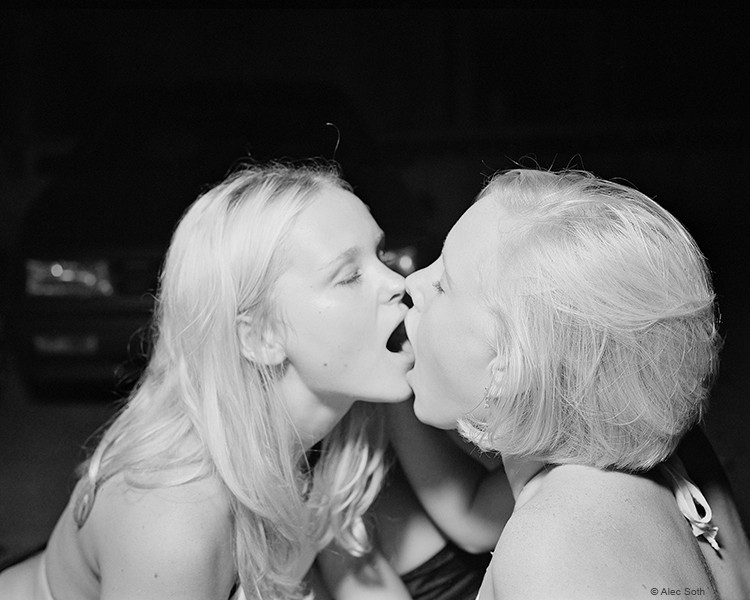Alec Soth | Natalia Stachon | Ulrich Wüst
Topografien
08 Sep - 21 Dec 2017
The exhibition “Topographies” presents photographs by Alec Soth and Ulrich Wüst, as well as new drawings and a neon sculpture by Natalia Stachon. What these artists all have in common is their interest in ambivalences: ambivalences in urban and social as well as physical and emotional spaces. Urbanity and landscape, especially the photographic reception of the landscape in the U.S., are points of reference here. In the 1970s in the U.S., the genre of landscape photography was newly rediscovered by various photographers like Stephen Shore, Robert Adams, Ed Ruscha, Nicholas Nixon, and Lewis Baltz. They directed their gaze to built landscapes, designed and destroyed by man: streets, warehouses, industrial plants, parking lots, and peripheries, and they did so in an analytical and complex manner, using an objectivizing visual vocabulary. In this way, they resisted the anecdotal and picturesque forms of expression favored by traditional American landscape photography of, for example, Edward Weston or Ansel Adams. They aestheticized the banal and confronted contradictory states: romanticizing beauty and ugliness, geographic expanse and industrial agglomeration.
The seminal exhibition “New Topographics: Photographs of a Man-altered Landscape” (1975; George Eastman
House; Rochester, New York) created a new genre within photography. “Basically, the photographers of the
New Topographics applied a kind of practical knowledge to create images that are beyond a doubt objective.
In terms of the logic of selection and references, indifference is an adequate parameter—quite stable in its
symmetry, reflexivity, and transitivity.”*
All three artists share an interest in the traces of human influence on geographic and topographic paradigms
of landscape. Alec Soth and Ulricht Wüst use the camera and black-and-white photography as their means of
expression, whereas Natalia Stachon uses documentary photographic fragments, which she collages and then
draws.
Alec Soth (*1969) photographed his series “Looking for Love” (1996) with a medium format camera. He takes
us on the continuous, deeply human search for love and community through landscapes of social encounters.
Urban sprawl and the parceling of regions through omnipresent uniform architectures in the contemporary U.S. are here transitory moments mirroring social relationships.
Ulrich Wüst (*1949) also photographs locally. In continuation of his series “Stadtbilder” (1979-1984), “Berlin
Mitte” (1995-1997) and “Morgenstraße” (1998-2000) he applies his analytical method to a rural area north of
Berlin. In “DORF. Die Gemeinde Nordwestuckermark” (2014 ff.), within the administrative borders of the district Nordwestuckermark he photographs the aesthetic confrontation of rural idylls and a complex reality.
Natalia Stachon (*1976) will show new drawings from the series “The History of Aberrations” (2014-2017). They show nocturnal scenes with broken utility poles and dangling power lines, partially illuminated by headlights. They seem like film stills from a fictional road movie.
In addition, there is a new neon sculpture by the artist, whose title “Mind Screens of the Earth” (2017) goes
back to a quotation from the novel “Nova Express” (1964) by William S. Burroughs. The writer was a tireless
traveler who lived in many parts of the world. The experience of living in different places influenced his art and informed his understanding of the world. Burroughs once said that the artist shows us the intellectual path of our own past relationships. In his prose, he weaves his impressions into a tight net of various layers: the endless superimposition of language makes it seem that everything is interrelated, and suddenly makes sense.
* from: Britt Salvensen, in: New Topographics, Texte und Rezeption, Ausstellung Köln / Linz (2010/2011), p. 43
The seminal exhibition “New Topographics: Photographs of a Man-altered Landscape” (1975; George Eastman
House; Rochester, New York) created a new genre within photography. “Basically, the photographers of the
New Topographics applied a kind of practical knowledge to create images that are beyond a doubt objective.
In terms of the logic of selection and references, indifference is an adequate parameter—quite stable in its
symmetry, reflexivity, and transitivity.”*
All three artists share an interest in the traces of human influence on geographic and topographic paradigms
of landscape. Alec Soth and Ulricht Wüst use the camera and black-and-white photography as their means of
expression, whereas Natalia Stachon uses documentary photographic fragments, which she collages and then
draws.
Alec Soth (*1969) photographed his series “Looking for Love” (1996) with a medium format camera. He takes
us on the continuous, deeply human search for love and community through landscapes of social encounters.
Urban sprawl and the parceling of regions through omnipresent uniform architectures in the contemporary U.S. are here transitory moments mirroring social relationships.
Ulrich Wüst (*1949) also photographs locally. In continuation of his series “Stadtbilder” (1979-1984), “Berlin
Mitte” (1995-1997) and “Morgenstraße” (1998-2000) he applies his analytical method to a rural area north of
Berlin. In “DORF. Die Gemeinde Nordwestuckermark” (2014 ff.), within the administrative borders of the district Nordwestuckermark he photographs the aesthetic confrontation of rural idylls and a complex reality.
Natalia Stachon (*1976) will show new drawings from the series “The History of Aberrations” (2014-2017). They show nocturnal scenes with broken utility poles and dangling power lines, partially illuminated by headlights. They seem like film stills from a fictional road movie.
In addition, there is a new neon sculpture by the artist, whose title “Mind Screens of the Earth” (2017) goes
back to a quotation from the novel “Nova Express” (1964) by William S. Burroughs. The writer was a tireless
traveler who lived in many parts of the world. The experience of living in different places influenced his art and informed his understanding of the world. Burroughs once said that the artist shows us the intellectual path of our own past relationships. In his prose, he weaves his impressions into a tight net of various layers: the endless superimposition of language makes it seem that everything is interrelated, and suddenly makes sense.
* from: Britt Salvensen, in: New Topographics, Texte und Rezeption, Ausstellung Köln / Linz (2010/2011), p. 43

